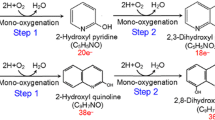Abstract
An indigenous mixed culture of microorganisms, isolated from a full-scale coal gasification wastewater treatment plant, was used in degrading quinoline in presence of glucose as an alternative carbon source. The results showed that biodegradation kinetics of both quinoline and glucose could be described by first-order reaction kinetics model. It was also found that the biodegradation rate of quinoline was accelerated by the presence of glucose, while glucose degradation was inhibited by the presence of quinoline. Both the biomass yield coefficient and specific growth rate were increased with the increasing of the glucose concentrations in the dual substrates system. A sum kinetics model was used to describe the relative effects of the two substrates on their individual uptakes. The interaction parameter values indicated that quinoline exhibits stronger inhibition on glucose degradation. But for glucose, its effect on quinoline utilization was stimulative. Furthermore, the stimulation was positively correlated with the concentration of glucose in the system.


Similar content being viewed by others
References
Bai Y, Sun Q, Zhao C, Wen D, Tang X (2010) Quinoline biodegradation and its nitrogen transformation pathway by a Pseudomonas sp. strain. Biodegradation 21:335–344
Cui MC, Chen FZ, Fu JM, Sheng GY, Sun GP (2004) Microbial metabolism of quinoline by Comamonas sp. World J Microb Biot 20:539–543
Dolores Murcia M, Gomez M, Gomez E, Gomez JL, Sinada FA, Christofi N (2012) Testing a Pseudomonas putida strain for 4-chlorophenol degradation in the presence of glucose. Desalin Water Treat 40:33–37
Fernandez I, Eugenia Suarez-Ojeda M, Perez J, Carrera J (2013) Aerobic biodegradation of a mixture of monosubstituted phenols in a sequencing batch reactor. J Hazard Mater 260:563–568
Hess TF, Silverstein J, Schmidt SK (1993) Effect of glucose on 2,4-dinitrophenol degradation kinetics in sequencing batch reactors. Water Environ Res 65:73–81
Lim BR, Hu HY, Ahn KH, Fujie K (2005) Effect of biodegradable substrates on the removal rate of concentrated p-phenol sulphonic acid in the solid phase aerobic biological treatment process. Process Biochem 40:2603–2607
O’loughlin EJ, Kehrmeyer SR, Sims GK (1996) Isolation, characterization, and substrate utilization of a quinoline-degrading bacterium. Int Biodeterior Biodegrad 38:107–118
Pakshirajan K, Chugh D, Saravanan P (2008) Feasibility of m-cresol degradation using an indigenous mixed microbial culture with glucose as co-substrate. Clean Technol Environ 10:303–308
Pichiah S, Kannan P, Prabirkumar S (2008) Kinetics of phenol and m-cresol biodegradation by an indigenous mixed microbial culture isolated from a sewage treatment plant. J Environ Sci-China 20:1508–1513
Sun Q, Bai Y, Zhao C, Xiao Y, Wen D, Tang X (2009) Aerobic biodegradation characteristics and metabolic products of quinoline by a Pseudomonas strain. Bioresour Technol 100:5030–5036
Tobajas M, Monsalvo VM, Mohedano AF, Rodriguez JJ (2012) Enhancement of cometabolic biodegradation of 4-chlorophenol induced with phenol and glucose as carbon sources by Comamonas testosteroni. J Environ Manag 95:116–121
Wang JL, Quan XC, Han LP, Qian Y, Hegemann W (2002) Microbial degradation of quinoline by immobilized cells of Burkholderia pickettii. Water Res 36:2288–2296
Yoon H, Klinzing G, Blanch HW (1977) Competition for mixed substrates by microbial populations. Biotechnol Bioeng 19:77–83
Zhang X, Yan K, Ren D, Wang H (2007) Studies on quinoline biodegradation by a white rot fungus (Pleurotus ostreatus BP) in liquid and solid state substrates. Fresenius Environ Bull 16:632–638
Zhao G, Chen S, Ren Y, Wei C (2014) Interaction and biodegradation evaluate of m-cresol and quinoline in co-exist system. Int Biodeterior Biodegrad 86:252–257
Ziagova M, Kyriakou G, Liakopoulou-Kyriakides M (2009) Co-metabolism of 2,4-dichlorophenol and 4-Cl-m-cresol in the presence of glucose as an easily assimilated carbon source by Staphylococcus xylosus. J Hazard Mater 163:383–390
Acknowledgments
This work was supported by Harbin Institute of Technology (2013DX10) and the Sino-Dutch Research Program (zhmhgfs2011-001).
Author information
Authors and Affiliations
Corresponding author
Rights and permissions
About this article
Cite this article
Xu, P., Ma, W., Han, H. et al. Biodegradation and Interaction of Quinoline and Glucose in Dual Substrates System. Bull Environ Contam Toxicol 94, 365–369 (2015). https://doi.org/10.1007/s00128-014-1388-1
Received:
Accepted:
Published:
Issue Date:
DOI: https://doi.org/10.1007/s00128-014-1388-1




